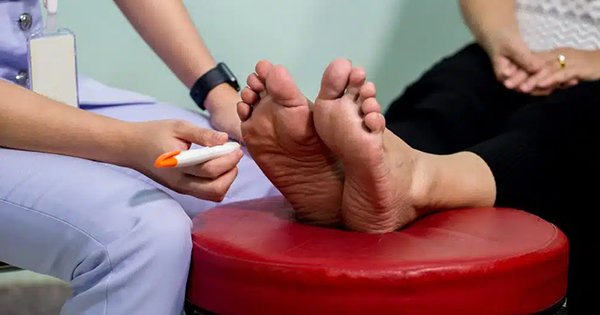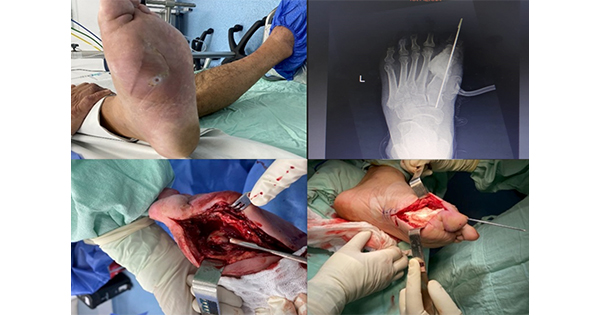I
nfection is a frequent complication of diabetic foot ulcers (DFUs) (Hobizal and Wukich, 2012). It is linked with poor clinical outcomes and high costs to both patient and healthcare systems. Patients with an infected DFU have a 50-fold increased risk of hospitalisation and a 150-fold increased risk of lower-extremity amputation compared to non-infected DFUs. Five percent of patients with infected ulcers will undergo a major amputation and 20–30% will likely suffer minor amputations (Pickwell et al, 2015).
Chronic wound infections can be superficial and/or deep compartment with each type exhibiting defined clinical signs and symptoms, and requiring topical and/or systemic treatment (Sibbald et al, 2006).
This article describes the range of antimicrobial dressings and translates the most current information from the literature on antimicrobial dressings for treating superficial infection in DFU into a quick reference guide for clinical practice.
From contamination to infection
All chronic wounds are populated with microorganisms and these are thought to interact with the wound in four (not necessarily distinct) stages (Landis et al, 2007; Sibbald et al, 2007):
- Contaminated wounds contain non-replicating microorganisms, but at this stage no clinical response is evoked in the host (Landis et al, 2007)
- Colonised wounds have replicating microorganisms attached superficially to the surface, but are typically not harmful to the host. Typical examples of colonising flora are Corynebacteria sp, coagulase negative staphylococci and viridans streptococci. It is important to stress here that colonisers are not necessarily pathogenic and, in fact, may accelerate wound healing (Landis et al, 2007)
- Critical colonisation/local infection. Although the concept of critical colonisation/local infection has been somewhat controversial (White and Cutting, 2006; Siddiqui and Bernstein, 2010), it can be characterised by presence of a replicating microbial burden in the wound surface compartment. At this stage, wound healing is delayed or stalled and there may also be subtle clinical signs of injury to the host (Landis et al, 2007). Quantitatively speaking, a wound is said to be critically colonised when bioburden levels reach 105 colony forming units (CFU) per gram of tissue (Woo et al, 2014).
- Wound infection has occurred when multiplying microorganisms infiltrate the deep compartment of a wound and the host begins to display explicit clinical signs of injury (Landis et al, 2007).
Development of wound infection is contingent on factors such as the virulence of the colonising organisms, the synergistic action of different bacterial species, the bioburden and, most importantly, the ability of the host to initiate an appropriate immunological response. The efficiency of the latter is influenced by both local conditions, for example, poor perfusion, necrosis, foreign bodies, wound size and location, undermining and tunnelling, and systemic/personal conditions including associated comorbidities, e.g. renal/liver impairment, poorly controlled diabetes; behavioural determinants, e.g. smoking, poor adherence to treatment plans, poor nutrition; and social determinants, e.g. education and socioeconomic background (Landis et al, 2007; Gethin, 2009; Siddiqui and Bernstein, 2010).
Identification of infection
Recognising infection in patients with a DFU is challenging, but it is a critical step in the overall wound assessment as clinicians have the potential to halt progression from a mild infection to a more severe problem.
Clinicians should firstly be aware of factors that increase the likelihood of infection in patients with a DFU (Wounds International, 2013):
- A positive probe-to-bone test
- DFU duration >30 days
- A history of recurrent DFUs
- A traumatic foot wound
- Presence of peripheral arterial disease (PAD) in the affected limb
- A previous lower-extremity amputation
- Loss of protective sensation
- Presence of renal insufficiency
- A history of walking barefoot.
Secondly, it should be remembered that aside from cases of osteomyelitis, laboratory testing has limited effectiveness in the detection of infection. That said, a semi-quantitative bacterial swab or a tissue biopsy will aid with identification of flora and organism sensitivity prior to starting antibiotic therapy (Alavi et al, 2014).
Thirdly, because of the limits associated with microbiological results, diagnosis of infection in a patient with a DFU largely comes down to observing relevant clinical signs and symptoms.
According to the Registered Nurses’ Association of Ontario (RNAO, 2013) guidelines for management of foot ulcers in persons with diabetes, any two signs and symptoms of inflammation or purulence indicate presence of infection. These include:
- Erythema
- Warmth
- Tenderness
- Pain
- Induration
- Purulent exudates).
The compartment model of wound infection separates wound infections into local or superficial wound surface infection typically caused by aerobic Gram-positive cocci (S. aureus) and betahemolytic streptococci, and deep/periwound (spreading infection) compartments (Sibbald et al, 2006; Botros et al, 2018). It outlines NERDS as:
- Non-healing wounds
- Exudative wounds
- Red and bleeding wound surface granulation tissue
- Debris (yellow or black necrotic tissue on the wound surface)
- Smell or unpleasant odour from the wound.
All of the above are signs and symptoms of local or superficial infection. Meanwhile, STONEES is an acronym of:
- Increased Size
- Increased Temperature
- Os (probe to exposed bone)
- Satellite or New areas of breakdown
- Exudate, erythema, oedema
- Smell.
All of the above are indicators of deep compartment infection (Sibbald et al, 2006). These correspond closely with the Infectious Diseases Society of America (IDSA)’s mild and moderate category infections (Lipsky et al, 2012). In a cross-sectional validation study, “any three criteria were found to provide sensitive and specific information about the amount of bacteria present in the wound when used by expert clinicians familiar with the mnemonic” (Woo and Sibbald, 2009).
It should be remembered at this point, however, that clinical signs of infection can be muted or absent because of diabetic complications, such as PAD, neuropathy and diminished leucocyte function. According to Alavi (2014): “Approximately 50% of diabetic patients with deep compartment infection in a foot ulcer lack systemic inflammatory response indicators of infection (i.e. diminished or lack of elevation of ESR or CRP, with a normal white blood cell count and body temperature), leading to a delayed diagnosis.”
Treatment
The compartment model of wound infection advocates treating deep compartment/periwound infection systemically, while superficially infected wounds tend to respond well to a topical antimicrobial regimen with the added benefit of averting potential side effects of systemic antibiotics (Young, 2012).
An antimicrobial regimen for treating superficial wound infection may involve direct application of a topical antimicrobial such as metronidazole gel, acetic acid or mupuricin ointment or, dressings impregnated with antimicrobial agents (RNAO, 2013).
Dressings can be impregnated with agents having diverse mechanisms of microbiocidal action, for example, antibiotics (Beta-lactams, sulphonamides, quinolones, tetracyclines); nanoparticles (ionic silver, zinc oxide, iron oxide); honey (Manuka); essential oils (peppermint, cinnamon, carvacrol, geraniol) chitosan (a polysaccharide derived from shrimp shells); iodine (povidone, cadexomer); and chlorhexidine or polyhexamethylene-biguanide (PHMB) (Fletcher, 2006; Vowden et al, 2011; Simões et al, 2018).
In relation to dressings and DFUs, however, most of the emphasis in clinical practice guidelines (CPG) and best practice recommendations (BPR) appears to be on ensuring that dressings that provide optimal moisture balance or aid with debridement for local wound care are selected (RNAO, 2013; Wounds International, 2013; Hingorani et al, 2016; International Diabetes Federation, 2017; Botros et al, 2018). Of those CPGs and BPRs that do refer to antimicrobial dressings (RNAO, 2013; Wounds, 2013; Hingorani et al, 2016), silver-, iodine-, PHMB- and honey-impregnated dressings would appear to be the most commonly accepted, but they are not discussed in any great detail and there is some inconsistency with respect to aspects of the dressings that are discussed, for example, Wounds International best practice guidelines report contra-indications in terms of the nature of the wound for iodine- and PHMB-impregnated dressings, but RNAO and SVS guidelines do not (Table 1).
A Cochrane systematic review of topical antimicrobial agents for treating foot ulcers in people with diabetes (Dumville et al, 2017) reports that pooled data from five trials, one with short-term follow up (4 weeks) and 4 with medium-term follow up (8–24 weeks), three evaluating silver containing dressings, one a honey-containing dressing, and one an iodine containing dressing with a total of 945 participants indicates that “more wounds may heal when treated with an antimicrobial dressing than with a non-antimicrobial dressing (relative risk [RR]: 1.28, 95%, confidence interval [CI] 1.12–1.45).”
However, the authors “consider this low-certainty evidence (downgraded twice due to risk of bias)”. The evidence on adverse events or other outcomes was “uncertain (very low-certainty evidence, frequently downgraded due to risk of bias and imprecision).”
A second systematic review from 2006 (Nelson et al, 2006) concluded that “there is no strong evidence for any particular antimicrobial agent for the prevention of amputation, resolution of infection, or ulcer healing.” However, they did conclude that “cadexomer iodine dressings may cost less than daily dressings”. Again, the overall quality of trials was deemed to be poor and inadequately powered to detect important clinically, statistically significant differences in effectiveness. The authors also thought that there was heterogeneity of outcomes reported and a risk of selective outcome reporting bias as trials tended not to specify primary outcomes a priori.
Conclusion
Patients with diabetes and foot ulcers are complex cases. It can be challenging to diagnose infection when it occurs and the consequences of an unchecked infection can be serious and far-reaching, in many cases leading to major amputation or even death. It is greatly preferable that infection be detected and treated in the early (local or superficial) stages, rather than later when infection has spread to deep compartment or periwound area. While treatment choices for the latter are well established, options for the former are less clear cut with minimal or no coverage in practice guidelines and a weak evidence base. Future initiatives should look at larger, more robust clinical trials of antimicrobial dressings, putting clinicians in a stronger position to make choices that best benefit their patients.




